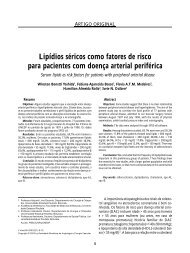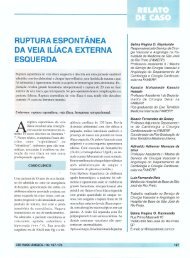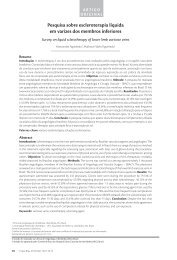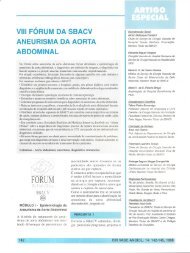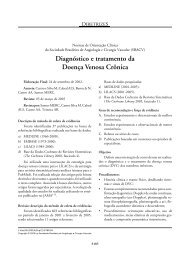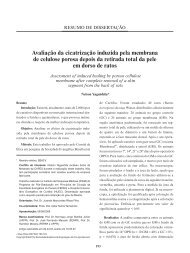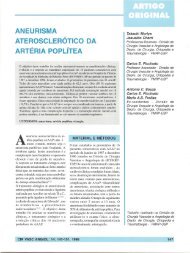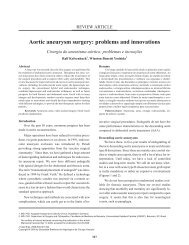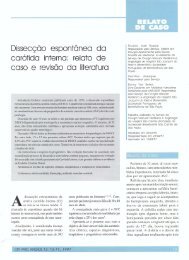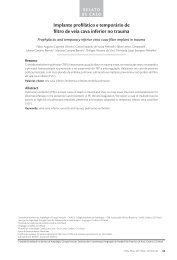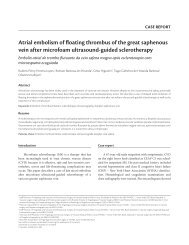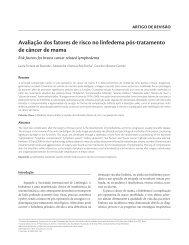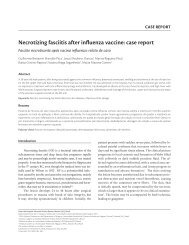Are femorodistal bypass grafts for acute limb ischemia worthwhile?
Are femorodistal bypass grafts for acute limb ischemia worthwhile?
Are femorodistal bypass grafts for acute limb ischemia worthwhile?
You also want an ePaper? Increase the reach of your titles
YUMPU automatically turns print PDFs into web optimized ePapers that Google loves.
Femorodistal <strong>bypass</strong> <strong>grafts</strong> <strong>for</strong> <strong>acute</strong> <strong>limb</strong> <strong>ischemia</strong> - Khandanpour N et al. J Vasc Bras 2009, Vol. 8, N° 4 295<strong>grafts</strong>; these include diameter and quality of vein, qualityof distal run off and diabetes mellitus. 8-11 Compared to supragenicular<strong>bypass</strong> surgery, infragenicular surgery is usuallyassociated with a more severe atherosclerosis andoutcome is less favorable.Many patients requiring <strong>femorodistal</strong> <strong>bypass</strong> reconstructionare admitted on an emergency basis. Althoughthere are numerous reports on the outcomes of infrageniculate<strong>bypass</strong> surgery in the literature, 12-14 the effect ofmode of admission on these outcomes has not been ascertained.The aim of this study was to determine whether<strong>femorodistal</strong> revascularization <strong>for</strong> <strong>acute</strong> <strong>ischemia</strong> withprosthetic <strong>grafts</strong> is <strong>worthwhile</strong>.Materials and methodsPrimary patency, <strong>limb</strong> salvage and mortality rates inan emergent and elective series with natural and prosthetic<strong>grafts</strong> were surveyed in a retrospective study. The outcomesof 147 consecutive <strong>femorodistal</strong> revascularizationprocedures per<strong>for</strong>med between January 1996 and March2006 were studied.Patients were followed up <strong>for</strong> up to 48 months. Patientswith elective admission were followed up <strong>for</strong> 30.7months on average. All operations were per<strong>for</strong>med by oneof five consultants in the vascular surgery department. Allpatients were considered <strong>for</strong> a vein graft as a first-line measure.If a vein was not available a prosthetic graft was used.Patency was assessed by clinical examination of therevascularized <strong>limb</strong> and measurement of arterial brachialpressure indexes (ABPIs) in all patients, with surveillanceduplex scan referred <strong>for</strong> symptomatic patients. All patientswere considered <strong>for</strong> percutaneous transluminal angioplastyafter graft stenosis as the initial treatment. Primarygraft patency was defined as uninterrupted patency with noprocedures per<strong>for</strong>med on the graft or its anastomoses. 15Secondary patency referred to a status that flow was restoredthrough most of the original graft, including at leastone of its original anastomoses. 15 Patients were sufferingfrom chronic <strong>limb</strong> <strong>ischemia</strong>. Emergent admissions <strong>for</strong> <strong>femorodistal</strong>revascularization <strong>for</strong> <strong>acute</strong> <strong>ischemia</strong> were definedas non-planned admissions that occurred in less than96 hours from the outpatients visit.The results of this study are reported according to thereport of Society of Vascular Surgery and InternationalSociety of Cardiovascular Surgery (SVS/ISCVS) ad hoccommittee. 15Statistical analysis was per<strong>for</strong>med by Stata statisticalsoftware (version 9.2). Survival functions were calculatedusing the log-rank test. Cox regression was used to investigatethe effects of possibly confounding variables, with theproportional hazards assumption being checked using agraphical method (log-log plots). Significance was definedasap
296 J Vasc Bras 2009, Vol. 8, N° 4 Femorodistal <strong>bypass</strong> <strong>grafts</strong> <strong>for</strong> <strong>acute</strong> <strong>limb</strong> <strong>ischemia</strong> - Khandanpour N et al.Table 1 - Patient characteristicsCharacteristic Elective Emergency p*Mean age, years (range) 76.19.48 (44-104) 71.411.4 (42-95) 0.003Male, % (no.) 61 (51/84) 63.5 (40/63) 0.459Risk factors, no. (%)Diabetes 33 (39.28) 34 (53.98) 0.357Hypertension 34 (40.47) 37 (58.73) 0.028Coronary artery disease 50 (59.52) 59 (93.65) < 0.0001Smoker 51 (60.81) 52 (82.53) 0.004Cerebrovascular disease 13 (14.86) 9 (14.28) 0.841* Differences between groups tested using two-sample t-test (age) and chi-square test (other variables).Table 2 - Ruther<strong>for</strong>d stratification of participantsCharacteristic Elective, no. (%) Emergency, no. (%)Severe claudication (category 3, grade 1) 53 (63.09) N/AIschemic rest pain (category 4, grade 2) 5 (5.95) 49 (77.77)Tissue loss (category 5, grades 3 and 4) 26 (30.95) 14 (22.23)Table 3 - Details of anastomotic sitesSites of anastomosisVein,no. (%)Prosthetic,no. (%)Common femoroposterior tibial 40 (27) 36 (25)Common femoroanterior tibial 20 (14) 28 (19)Common femoroperoneal 6 (4) 6 (4)Superficial femoroanterior tibial 2 (1) 2 (1)Superficial femoroposterior tibial 2 (1) 0 (0)Popliteo-posterior tibial artery 4 (3) 1 (1)Figure 1 - Primary patency of vein vs. prosthetic graft in emergencySecondary graft patencyCumulative secondary patency rate at 2 years <strong>for</strong> electivecases was 47 vs. 29% <strong>for</strong> emergent cases. At 2 years,secondary patency <strong>for</strong> patients treated with prosthetic graftwas 34 vs. 45% <strong>for</strong> vein <strong>grafts</strong>. Cox regression showed thatmode of admission was a significant factor affecting outcomesof secondary patency (p = 0.01). Two patients in theelective group vs. four patients in the emergency group receivedsecondary intervention. Four thrombectomies and 2percutaneous transluminal angioplasties (PTA) were per<strong>for</strong>med.Figure 2 - Primary patency according to mode of admission
Femorodistal <strong>bypass</strong> <strong>grafts</strong> <strong>for</strong> <strong>acute</strong> <strong>limb</strong> <strong>ischemia</strong> - Khandanpour N et al. J Vasc Bras 2009, Vol. 8, N° 4 297Limb salvagePatients undergoing elective admissions did significantlybetter than their femoropopliteal <strong>bypass</strong> <strong>grafts</strong> <strong>for</strong><strong>acute</strong> <strong>ischemia</strong> group (p < 0.004). Total elective <strong>limb</strong> salvagerate was 72 vs. 49% <strong>for</strong> emergent operations at 2 yearsand 60 vs. 49% at 4 years (p < 0.004).In emergency setting, patients treated with prosthetic<strong>grafts</strong> had less favorable outcomes vs. patients treated withvein <strong>grafts</strong>, having a <strong>limb</strong> salvage rate of 38 vs. 62% at 2and 4 years. In a sub-analysis of the rate of <strong>limb</strong> salvage inadmissions <strong>for</strong> <strong>femorodistal</strong> <strong>grafts</strong> <strong>for</strong> <strong>acute</strong> <strong>ischemia</strong> therate of prosthetic <strong>grafts</strong> was 62 vs. 37% <strong>for</strong> vein <strong>grafts</strong> atboth time points. Figure 3 illustrates a plot <strong>for</strong> <strong>limb</strong> salvage<strong>for</strong> prosthetic and vein <strong>grafts</strong> in patients with emergentadmission. There was no statistically significant differencebetween the rate of <strong>limb</strong> salvage of vein and prosthetic<strong>grafts</strong> in emergent admissions (p = 0.84).Survival ratesThe 30-day mortality rate was 2.72% (n = 4). Threewere elective cases and one emergent admission. All fourmortality cases had vein <strong>grafts</strong>. Fifty six (30%) patientsdied during follow up. The most common cause of deathwas myocardial infarction. There was no significant differencein mortality rates of the two groups (p = 0.838). Table4 summarizes the causes of death <strong>for</strong> both groups.Figure 3 - Limb salvage in emergent admissions according totype of graftTable 4 - All causes of death (4 years)All causes of death Elective EmergencyMI 15 9Stroke 0 4Cardiorespiratory failure 7 6Chronic renal failure 4 1Pneumonia 2 1Other 3 3Total 32 24MI = myocardial infarction.Risk factors <strong>for</strong> graft failure and <strong>limb</strong> lossCox regression analysis was used <strong>for</strong> assessing simultaneouseffects of several covariates, in a stratified analysis.Mode of admission was a significant factor <strong>for</strong> primaryand secondary patencies (p = 0.01), in a model which adjusted<strong>for</strong> age, sex, graft type and smoking and disease status.The adjusted hazard ratio (95% confidence interval,95%CI) <strong>for</strong> salvage rate was 1.99 (95%CI 1.18-3.37). Tables5 and 6 illustrate the Cox models that primary patencyand salvage rates are adjusted <strong>for</strong> the confounding factors.DiscussionVein <strong>grafts</strong> are known to be superior to the prosthetic<strong>grafts</strong>. 16 However, coronary artery <strong>bypass</strong> <strong>grafts</strong>, varicosevein operations, and a poor quality vein deprive 15-30% ofthe patients from a vein graft. 17-19 This study aimed to justifywhether emergent <strong>femorodistal</strong> revascularization withprosthetic <strong>grafts</strong> is <strong>worthwhile</strong>. In this study elective admissionshad both higher patency and salvage rates(p < 0.004). However, the type of graft did not lead in a significantlypoorer outcomes <strong>for</strong> emergent operations(p = 0.084).This study was consistent with other studies showingthe superiority of autogenous vein <strong>grafts</strong> over prosthetic<strong>grafts</strong>. 20,21Despite a lower patency rate with prosthetic <strong>grafts</strong>,38% of the patients treated emergently maintained graftpatency and <strong>limb</strong> salvage at 2 years. There<strong>for</strong>e, the absenceof a suitable vein should not mandate primary amputation.The type of graft did not affect outcome during emergencyoperations. Our results compare favorably to theprimary and secondary patency rates reported in the literature(Table 7).Whether to submit patients to a <strong>femorodistal</strong> <strong>bypass</strong>is a complex decision making process, weighing up lifequality against mortality and morbidity of the procedure.27,28 Patient’s interest, availability of vein, patient’s comorbiditieswith resources available need to be consideredin decision making. 29,30 In a sense all <strong>femorodistal</strong> <strong>bypass</strong>procedures are urgent or emergent procedures. Non-emergentadmission played an important role in defining the
298 J Vasc Bras 2009, Vol. 8, N° 4 Femorodistal <strong>bypass</strong> <strong>grafts</strong> <strong>for</strong> <strong>acute</strong> <strong>limb</strong> <strong>ischemia</strong> - Khandanpour N et al.Table 5 - Cox models developed to assess the effect of potential confounding factors. Primary patencyVariable Unadjusted hazard ratio (95%CI) p Adjusted hazard ratio (95%CI) pAge 65-79 (compared to < 65) 1.07 (0.60-1.91) 0.809 1.31 (0.69-2.51) 0.410Age 80+ (compared to < 65) 0.95 (0.50-1.79) 0.869 1.22 (0.57-2.64) 0.605Male (compared to female) 1.40 (0.92-2.15) 0.117 1.46 (0.91-2.34) 0.120Admission (emergent compared to elective) 1.82 (1.22-2.73) 0.004 2.05 (1.20-3.49) 0.008Graft type (prosthetic graft compared to1.43 (0.95-2.15) 0.089 1.37 (0.87-2.16) 0.180vein)Ruther<strong>for</strong>d stratification 3.1 (compared to1.09 (0.67-1.75) 0.733 1.14 (0.69-1.89) 0.6125.3)Ruther<strong>for</strong>d stratification 4.2 (compared to1.18 (0.41-3.43) 0.762 2.09 (0.63-6.93) 0.2295.3)Smoking 1.35 (0.84-2.19) 0.219 1.18 (0.68-2.07) 0.556Diabetes 0.95 (0.63-1.44) 0.815 0.80 (0.51-1.25) 0.334Hypertension 0.99 (0.66-1.50) 0.980 0.99 (0.63-1.56) 0.966Ischemic heart disease 1.36 (0.83-2.21) 0.222 0.95 (0.51-1.78) 0.883Stroke 0.81 (0.45-1.43) 0.459 0.84 (0.45-1.57) 0.58895%CI = 95% confidence interval.Table 6 - Results of Cox proportional hazards modeling: confidence intervalVariable Unadjusted hazard ratio (95%CI) p Adjusted hazard ratio (95%CI) pPrimary patencyAdmission (emergent compared to elective) 1.82 (1.22-2.73) 0.004 2.05 (1.20-3.49)* 0.008Graft type (prosthetic graft compared to1.43 (0.95-2.15) 0.089 1.37 (0.87-2.16) † 0.180vein)Secondary patencyAdmission (emergent compared to elective) 1.76 (1.18-2.63) 0.006 2.04 (1.19-3.52)* 0.010Graft type (prosthetic graft compared to1.41 (0.94-2.13) 0.099 1.35 (0.85-2.14) † 0.205vein)Limb salvageAdmission (emergent compared to elective) 2.17 (1.28-3.66) 0.004 2.89 (1.41-5.91)* 0.004Graft type (prosthetic graft compared tovein)2.09 (1.22-3.60) 0.008 2.47 (1.35-4.54) † 0.00395%CI = 95% confidence interval.* Adjusted <strong>for</strong> graft type, age, sex, Ruther<strong>for</strong>d stratification, smoking status, presence of diabetes, hypertension, coronary artery diseaseand stroke.† Adjusted <strong>for</strong> admission mode, age, sex, Ruther<strong>for</strong>d stratification, smoking status, presence of diabetes, hypertension, coronary artery diseaseand stroke.outcomes of <strong>femorodistal</strong> <strong>bypass</strong> surgery in this study.There<strong>for</strong>e, <strong>for</strong> suitable patients, surgery should be offeredbe<strong>for</strong>e reaching a critical point, needing emergent intervention.Patients should not be deterred from <strong>bypass</strong> surgerytreatment on the basis of age or emergent admission.31,32Ouriel et al. and Raviola et al. studies, however, havesuggested that revascularization results are favorable comparedto amputation, in the terms of efficacy of treatmentand cost. 20,21,28,31 Revascularization has also been found toadvance the quality of life by decreasing pain level and sleepproblems and chances to avoid institutionalization.
Femorodistal <strong>bypass</strong> <strong>grafts</strong> <strong>for</strong> <strong>acute</strong> <strong>limb</strong> <strong>ischemia</strong> - Khandanpour N et al. J Vasc Bras 2009, Vol. 8, N° 4 299Table 7 - Primary and secondary patency in published seriesCumulative primary patency (%) Cumulative <strong>limb</strong> salvage (%)Study 1st year 2nd year 3rd year 1st year 2nd year 3rd yearVein graftPanayiotopoulos et al. 22 81.1 N/A 81.1 N/A N/A N/AFeinglass et al. 13 N/A N/A N/A 77 N/A 63Murphy et al. 23 12 4 N/A 22 10 N/AProsthetic graftFlinn et al. 24 58 45 N/A N/A N/A N/AWhittemore et al. 25 25 12 N/A N/A N/A N/APanayiotopoulos et al. 22 64.8 N/A 59.8 N/A N/A N/AGriffiths et al. 26 N/A 35 N/A N/A N/A 19In conclusion, when there was no appropriate longsaphenous vein, prosthetic graft was a reasonable substituteeven in the emergency situations. Prosthetic <strong>grafts</strong> had arather low rate of graft patency but acceptable long term<strong>limb</strong> salvage. This study illustrated that admitting patientson a planned basis will lead to better outcomes than waitinga crisis to develop (<strong>limb</strong> salvage p < 0.004).AcknowledgementThe authors would like to thank J.M.F. Clarke, Y.G.Wilson, and D.R. Morrow, consultant vascular surgeons,from the Norfolk and Norwich University Hospital, <strong>for</strong>their contributions.References1. Kunlin J. Long vein transplantation in treatment of <strong>ischemia</strong>caused by arteritis. Rev Chir. 1951;70:206-35.2. Campbell CD, Brooks DH, Webster MW, Diamond DL, PeelRL, Bahnson HT. Expanded microporous polytetrafluoroethyleneas a vascular substitute: a two year follow-up. Surgery.1979;85:177-83.3. Eskelinen E, Lepäntalo M, Hietala EM, et al. Lower <strong>limb</strong> amputationsin Southern Finland in 2000 and trends up to 2001.Eur J Vasc Endovasc Surg. 2004;27:193-200.4. Quiñones-Baldrich WJ, Busuttil RW, Baker JD, et al. Is thepreferential use of polytetrafluoroethylene <strong>grafts</strong> <strong>for</strong> femoropopliteal<strong>bypass</strong> justified? J Vasc Surg. 1988;8:219-28.5. Pereira CE, Albers M, Romiti M, Brochado-Neto FC, PereiraCA. Meta-analysis of femoropopliteal <strong>bypass</strong> <strong>grafts</strong> <strong>for</strong>lower extremity arterial insufficiency. J Vasc Surg.2006;44:510-7.6. Aracil-Sanus E, Mendieta-Azcona C, Cuesta-Gimeno C,Chinchilla-Molina A. Infrageniculate <strong>bypass</strong> graft <strong>for</strong> <strong>limb</strong>salvage using polytetrafluoroethylene and distal vein cuff asthe first alternative in patients without ipsilateral greatersaphenous vein. Ann Vasc Surg. 2005;19:379-85.7. Berglund J, Björck M, Elfström J; SWEDVASC FemoropoplitealStudy Group. Long-term results of above kneefemoro-popliteal <strong>bypass</strong> depend on indication <strong>for</strong> surgeryand graft-material. Eur J Vasc Endovasc Surg.2005;29:412-8.8. Luther M. Treatment of chronic critical leg ischaemia: a costbenefit analysis. Ann Chir Gynaecol Suppl. 1997;213:1-142.9. Karacagil S, Almgren B, Bowald S, Eriksson I. Bypass graftingto the popliteal artery in <strong>limb</strong>s with occluded crural arteries.Am J Surg. 1991;162:19-23.10. Panetta TF, Marin ML, Veith FJ, et al. Unsuspected preexistingsaphenous vein disease: an unrecognized cause of vein<strong>bypass</strong> failure. J Vasc Surg. 1992;15:102-10.11. Davies AH. Vein factors that affect the outcome of <strong>femorodistal</strong><strong>bypass</strong>. Ann R Coll Surg Engl. 1995;77:63-6.12. Kersting S, Ockert D, Zimmermann T, Meichelbock W,Saeger HD, Bergert H. Infragenicular polytetrafluoroethylene<strong>bypass</strong> with tapered versus straight vascular <strong>grafts</strong>: resultsfrom a prospective multicenter cohort study. Ann VascSurg. 2004;18:440-7.13. Feinglass J, Pearce WH, Martin GJ, et al. Postoperative andamputation-free survival outcomes after <strong>femorodistal</strong> <strong>bypass</strong>grafting surgery: findings from the Department of VeteransAffairs National Surgical Quality Improvement Program. JVasc Surg. 2001;34:283-90.14. Watson HR, Schroeder TV, Simms MH, Horrocks M. Associationof sex with patency of <strong>femorodistal</strong> <strong>bypass</strong> <strong>grafts</strong>. EurJ Vasc Endovasc Surg. 2000;20:61-6.15. Ruther<strong>for</strong>d RB, Baker JD, Ernst C, et al. Recommended standards<strong>for</strong> reports dealing with lower extremity <strong>ischemia</strong>: revisedversion. J Vasc Surg. 2001;33:805.16. Donaldson MC, Whittemore AD, Mannick JA. Further experiencewith an all-autogenous tissue policy <strong>for</strong> infrainguinalreconstruction. J Vasc Surg. 1993;18:41-8.17. Bastounis E, Georgopoulos S, Maltezos C, Alexiou D, ChiotopoulosD, Bramis J. PTFE-vein composite <strong>grafts</strong> <strong>for</strong> critical<strong>limb</strong> ischaemia: a valuable alternative to all-autogenousinfrageniculate reconstructions. Eur J Vasc Endovasc Surg.1999;18:127-32.
300 J Vasc Bras 2009, Vol. 8, N° 4 Femorodistal <strong>bypass</strong> <strong>grafts</strong> <strong>for</strong> <strong>acute</strong> <strong>limb</strong> <strong>ischemia</strong> - Khandanpour N et al.18. Taylor LM, Edwards JM, Porter JM. Present statues of reversedvein <strong>bypass</strong> grafting: five-year results of a modern series.J Vasc Surg. 1990;11:193-206.19. Donaldson MC, Whittemore AD, Mannick JA. Further experiencewith man all autogenous vein policy <strong>for</strong> infrainguinalreconstruction. J Vasc Surg. 1993;18:41-8.20. Hobson RW 2nd, O’Donnell JA, Jamil Z, Mehta K. Below-knee<strong>bypass</strong> <strong>for</strong> <strong>limb</strong> salvage. Comparison of autogenoussaphenous vein, polytetrafluoroethylene, and compositedacron-autogenous vein <strong>grafts</strong>. Arch Surg.1980;115:833-7.21. Harris JP, O’Brien CJ, Stephen MS, Sheil AG, May J. Shouldpolytetrafluoroethylene <strong>grafts</strong> be used in preference to saphenousvein <strong>for</strong> femoropopliteal arterial <strong>bypass</strong>? AustNZJSurg. 1985;55:579-83.22. Panayiotopoulos YP, Edmondson RA, Reidy JF, Taylor PR.A scoring system to predict the outcome of long <strong>femorodistal</strong>arterial <strong>bypass</strong> <strong>grafts</strong> to single calf or pedal vessels. Eur JVasc Endovasc Surg. 1998;15:380-6.23. Murphy GJ, Kipgen D, Dennis MJ, Sayers RD. An aggressivepolicy of bilateral saphenous vein harvest <strong>for</strong> infragenicularrevascularisation in the era of multidrug resistantbacteria. Postgrad Med J. 2002;78:339-43.24. Flinn WR, Rohrer MJ, Yao JS, McCarthy WJ, Fahey VA,Bergan JJ. Improved long-term patency of infra-genicularpolytetrafluoroethylene <strong>grafts</strong>. J Vasc Surg. 1988;7:685-90.25. Whittemore AD, Kent KC, Donaldson MC, Couch NP,Mannick JA. What is the proper role of polytetrafluoroethylene<strong>grafts</strong> in infra-inguinal reconstruction? J Vasc Surg.1989;10:299-305.26. Griffiths GD, Nagy J, Black D, Stonebridge PA. Randomizedclinical trial of distal anastomotic interposition vein cuff ininfrainguinal polytetrafluoroethylene <strong>bypass</strong> grafting. Br JSurg. 2004;91:560-2.27. Conte MS, Belkin M, Upchurch GR, Mannick JA, WhittemoreAD, Donaldson MC. Impact of increasing comorbidityon infrainguinal reconstruction: a 20-year perspective.Ann Surg. 2001;233:445-52.28. Raviola CA, Nichter LS, Baker JD, Busuttil RW, MachlederHI, Moore WS. Cost of treating advanced leg <strong>ischemia</strong>. Bypassgraft vs primary amputation. Arch Surg. 1988;123:495-6.29. Gupta SK, Veith FJ, Ascer E, Flores SA, Gliedman ML. Costfactors in <strong>limb</strong>-threatening ischaemia due to infrainguinal arteriosclerosis.Eur J Vasc Surg. 1988;2:151-4.30. Mackey WC, McCullough JL, Conlon TP, et al. The costs ofsurgery <strong>for</strong> <strong>limb</strong>-threatening <strong>ischemia</strong>. Surgery.1986;99:26-35.31. Ouriel K, Fiore WM, Geary JE. Limb-threatening <strong>ischemia</strong>in the medically compromised patient: amputation or revascularization?Surgery. 1988;104:667-72.32. Friedman SG, Kerner BA, Friedman MS, Moccio CG. Limbsalvage in elderly patients. Is aggressive surgical therapywarranted? J Cardiovasc Surg (Torino). 1989;30:848-51.Correspondence:Dr. Nader KhandanpourVascular Surgery DepartmentNorfolk and Norwich University Hospital NHS TrustNR4 7UY – Norwich, United KingdomE-mail: nkh950@yahoo.comAuthor contributionsConception and design: NK, FJM, LC, MPAAnalysis and interpretation: NK, FJM, JS, MPAData collection: NK, LCWriting the article: NK, FJM, LC, JS, MPACritical revision of the article: NK, FJM, JS, MPAFinal approval of the article*: NK, FJM, LC, JS, MPAStatistical analysis: JSOverall responsibility: NK, FJM, LC, JS, MPAObtained funding: N/A*All authors have read and approved of the final version ofthe article submitted to J Vasc Bras.



